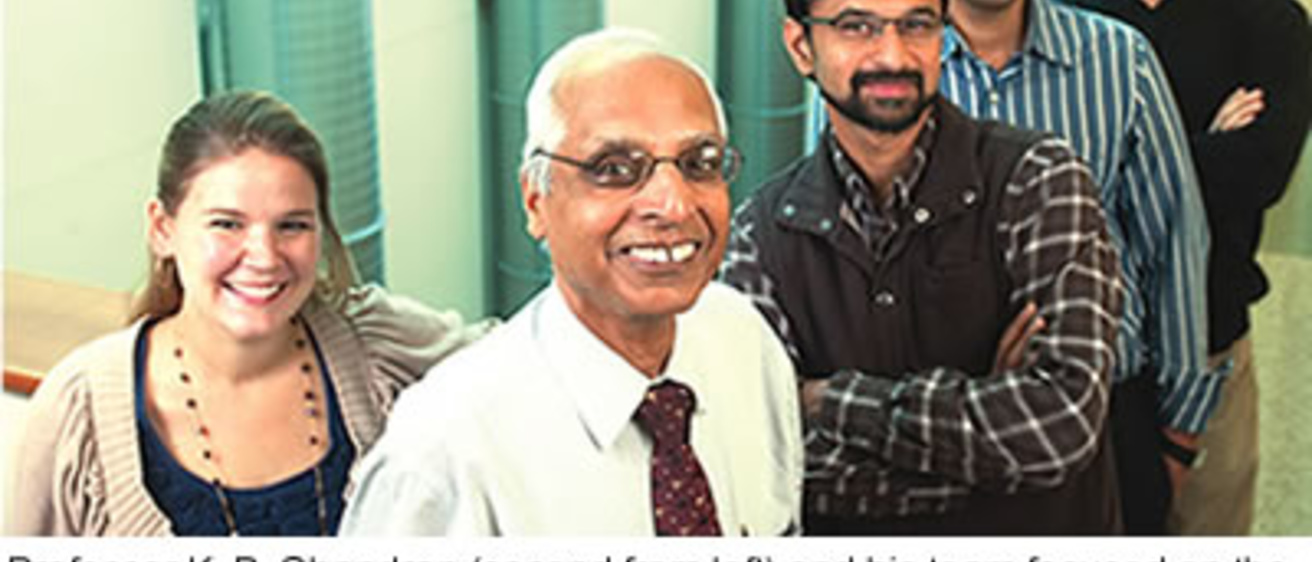Thursday, August 14, 2014
The history of biomedical engineering at Iowa is not simply a litany of names and dates; it is a narrative of people and relationships shaped by thoughtful, visionary leaders.
Among those talented leaders is Lowell Battershell Endowed Chair of Biomedical Engineering Krishnan B. Chandran, whose wise mentoring of students and peers has helped create and grow the department during his 36-year tenure at Iowa, including nine years as departmental executive officer.
When the Greek hero Odysseus left for the Trojan War, he asked his friend Mentor to care for the intellectual and moral development of his son, Telemachus. In his own mentoring of less experienced students and colleagues, Chandran likewise has offered his support, balancing the wisdom that comes from experience with the intellectual freedom to learn on one’s own.
“As an advisor, he was always available when needed,” says assistant professor of biomedical engineering Sarah Vigmostad who as a graduate student was among Chandran’s advisees. “And yet he also allowed his students the space they needed to navigate through their research as they saw fit. This balanced approach allowed his students to think and work independently, yet with the confidence and comfort of knowing that he would be there for us in times when we became lost or were stuck.”
Chandran notes that the professional success of students and faculty members must be measured beyond research progress and outcomes to include professional behavior.
“Biomedical engineers necessarily have to collaborate,” he says, “and that means learning how to work with and respect the expertise of people in an array of fields, including physicians, lab technicians, and basic scientists. I always encourage our biomedical
engineering students to behave with integrity and honesty, much like the standards my own mentors held for me.”
The role of mentor, therefore, links one generation to the next in a way that reinforces and enriches the typical student teacher relationship. Chandran recalls that during his postdoctoral research at Tulane University, professor of biomedical engineering Y. King Liu strongly encouraged him to write grants and publish. When Liu was recruited to join Iowa’s fledgling Department of Biomedical Engineering in 1978, he negotiated for an associate professorship for his protégé, Chandran.
“He was a role model for me,” Chandran says, “and when I became chair at Iowa, I tried to follow his principles.”
Chandran helped young faculty members by positioning them in joint appointments where appropriate and beneficial to their careers. He paid close attention to their progress, not overloading them with teaching or committee work so they could succeed early in their research, publications, and collaborations. And the courses he assigned to them were those most likely to enable them to be successful as teachers.
David Wilder was one of the early-career faculty members Chandran supported. In 1994 Wilder arrived as a visiting associate professor from the University of Vermont along with professor of biomedical engineering Malcolm Pope. When Pope became departmental executive officer (DEO ) two years later, Wilder accepted a tenure-track position. Two years later, Chandran became DEO and continued to support Wilder’s professional development to full professor.
And since what goes around tends to come around, other faculty members in the department including Wilder—now mentor their own students and newer faculty members.
“Students need to be encouraged to follow their creative instincts and their intellectual insights,” Wilder says. “When I work with them, I operate on an intuitive level: I try to have a feel for the challenge at hand and the condition of the student, and then
go with my instincts. It’s kind of like ‘engineering standup.’”
Sarah Vigmostad notes that when she was an undergraduate at Iowa, Wilder would ask his students, “Are you surviving, or thriving?”—a question that at once indicated his interest in their professional development and sparked a degree of accountability in them. Chandran accomplished similar results by encouraging students like Sarah to apply to graduate school and by connecting students and faculty members to the broader biomedical engineering community at Iowa and beyond. While DEO , he worked with grad students to form a graduate student chapter of the Biomedical Engineering Student Society and often scheduled time for students to talk with visiting scholars.
As a scholar, teacher, and leader, Chandran has established a legacy of gifted, dedicated scholars, teachers, and leaders at Iowa and elsewhere—individuals who now look to him as a role model of the ideal mentor. Even in retirement, Chandran will continue in this role, mentoring not only his grandchildren near his new home in North Carolina but no doubt also continuing to support and encourage former students and colleagues.
